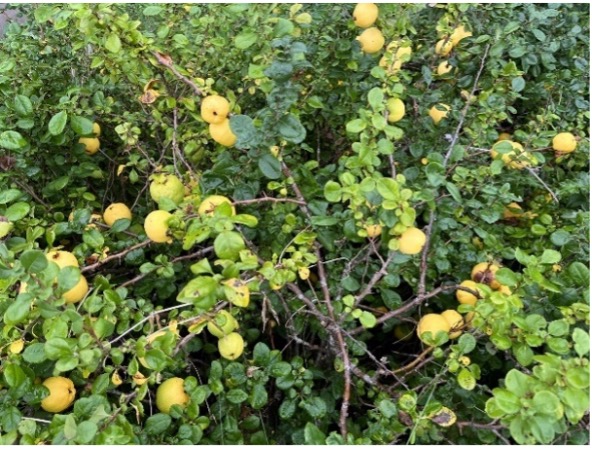
Preserving Workshops: Quince
At the start of September adult visitors to Ordsall Hall took part in a preserving workshop as part of our ongoing Sleeping Well project. Led by project officer, Dr Anna Fielding, groups of participants helped process produce from the Ordsall garden and orchard. Following the late summer grain harvest, the autumn fruit harvest would begin in earnest, alongside the gathering of the last flowers, herbs, and vegetables from the gardens. Processing and storing all of this allowed important ingredients to be available throughout the year until the following Summer. Knowledge of many different preservation techniques were required.
Anna thought this would be a good point in the year to explore some of these techniques to see how a family like the Radclyffes of Ordsall would ensure they had plenty of sleepy ingredients as part of the family’s healthcare management. Usually undertaken by the female members of the family, various foods would be candied, preserved, jellied, pickled, dried, crystallised, and distilled. Anna’s workshop had a particular focus on three main ingredients which can also tell us a lot about how early modern people cared for their sleep: quinces, roses, and sugar. All of these contributed to effective sleepy remedies and foods and featured adaptations that helped balance the body and mind ready for sleep.
This blog post, the first of three on food and preserving in the Autumn and Winter for sleep, will focus on the orchard with quinces. The next post will focus on flowers preserved with sugar, another sleepy ingredient according to early modern theory, and the final blog of this series will look at the use of spices and wine to heat the body as people celebrated Christmas alongside managing their diet and sleep.
Quinces:
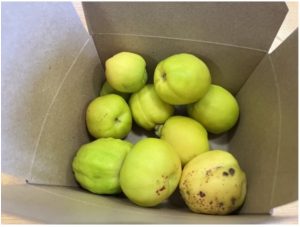
Quinces grown at Ordsall Hall. Photo credit: Anna Fielding.
We started the preserving workshop at Orsdall by collecting our ingredients from the orchard and gardens. Outdoor produce at the hall has been supporting our Sleeping Well activities all year long and it was lovely to be able to walk around the outdoor grounds and harvest what we needed. Quince gives off a wonderful aromatic perfume. Some participants had never used quince before and were surprised at the delicate fragrance. This was the first of many times during this recipe session that we employed our senses to help us create the sleepy foods.
We have written elsewhere on the Sleeping Well in the Early Modern World blog about the perceived early modern dangers of cold and moist fruit regarding the stomach and digestion. Generally speaking, fruit was safe to eat in the summer as it cooled down the body. Care needed to be taken from autumn onwards, however, as this cold and wet fruit could corrupt the stomach and cause foul vapours with the potential to upset digestion and sleep. Fruit had to be cooked and combined with dry and hot spices to temper it. Quinces, however, were believed to have a binding virtue that helped to strengthen the stomach. Herbalist John Gerard in 1597 advised eating quince paste so that the stomach ‘may retaine and keepe the meat therein until it be perfectly digested…’ Francis Bacon’s Sylva Sylvarum (1670) also praised quince as it ‘do induce sound sleep.’
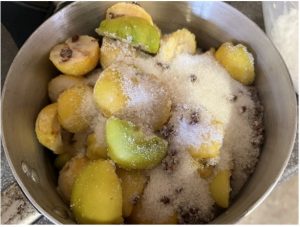
Halved quinces with sugar and water in a pan. Photo credit: Anna Fielding.
The first step for our quince preserve was to cut the fruits and put them in a pan with and equal amount of sugar and some water. As this was part of a workshop Anna opted for a white quince preserve rather than a red one (see below). We set this away bubbling while we prepped our roses.
Once we had a pan of cooked quinces, which had smelled amazing while they were cooking, we started the messy task of mashing and straining the fruit and pulp through a wire sieve. As we were also looking to use as much of the natural pectin from the fruit to help the mixture to set, we didn’t peel or core our quinces. This meant we had to separate them during this straining process.
The resulting preserve was a simple but delicious treat. It was perhaps a bit sharp and so more sugar could be added. We took this as evidence of how recipes would be tweaked according to taste and how the recipe didn’t feature all the necessary information that we required as a 21st century group remaking a 400-year-old recipe. Consulting early modern medical texts revealed that the tartness of the quince was an important factor. Its sharp nature closed the mouth of the stomach, akin to the reaction of your mouth puckering and tightening when you bite a lemon. The mixture could be used as a spread, or in pies and tarts. It would also be lovely mixed through a creamy pudding, or with yoghurt.
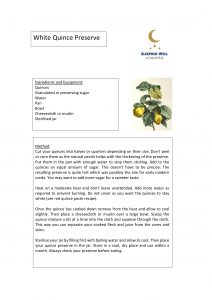 Looking at old quince preserving recipes from three old recipe collections revealed that quinces could also be preserved as a red paste. Closer examination of the recipe instructions showed how this red colour could be obtained through slowly boiling the fruit with more water and with the lid on. Some of the group were familiar with the Spanish quince paste ‘membrillo’, traditionally eaten with Manchego cheese. This is a solid block of hard red fragrant paste. Anna explained to the group how any marmalade recipe they saw in old cookbooks was actually this ‘membrillo’ paste and that the marmalade we know today, more runny and with oranges, was a later variation. The word ‘marmalade’ comes from ‘marmello’, the Portuguese for quince.
Looking at old quince preserving recipes from three old recipe collections revealed that quinces could also be preserved as a red paste. Closer examination of the recipe instructions showed how this red colour could be obtained through slowly boiling the fruit with more water and with the lid on. Some of the group were familiar with the Spanish quince paste ‘membrillo’, traditionally eaten with Manchego cheese. This is a solid block of hard red fragrant paste. Anna explained to the group how any marmalade recipe they saw in old cookbooks was actually this ‘membrillo’ paste and that the marmalade we know today, more runny and with oranges, was a later variation. The word ‘marmalade’ comes from ‘marmello’, the Portuguese for quince.
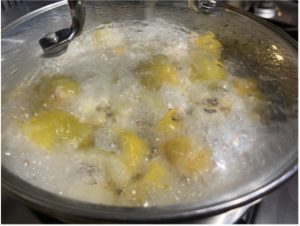
Cooking quinces in water. Photo credit: Anna Fielding.
Further exploration by Anna at home with the remaining quinces, using the 17th century recipes we had looked at during the session, resulted in a deep red quince paste. This was created by cooking up quinces again with the same quantity of sugar but with much more water and with the pan covered. Cooking the quince slower and for much longer meant they turned red. Some of the recipes also advised that this could be done in the oven.
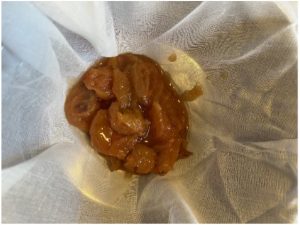
Straining the red cooked fruit. Photo credit: Anna Fielding.
Anna strained the red cooked fruits, together with the cores and skins for their pectin content, through a muslin or cheesecloth. As the mixture was strained, she squished the fruit flesh through the cloth to help thicken the paste.
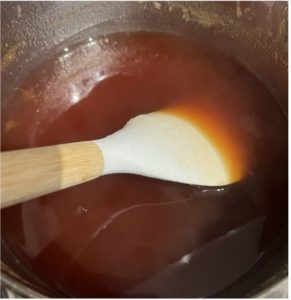
Thickening the red quince paste. Photo credit: Anna Fielding.
The next step was to heat this again, slowly, in a pan on the hob. After an hour of gentle heating, stirring all the time, Anna had a thick red paste which she put in a glass dish to set. The next morning the paste was solid and easy to cut. As with the quince preserve above, the paste was quite sour and tart so more sugar might be needed if you prefer.
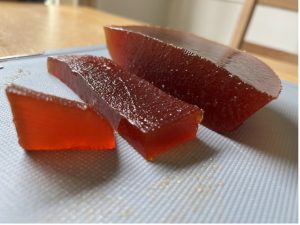
Red quince paste. Photo credit: Anna Fielding.
Anna took the paste to two further workshops at Chethams Library in Manchester the next day. Workshop participants there tasted our ‘marmalade’ and set a fresh batch of preserved red quinces away. The fruits turned the required ruby red colour by the end of the day.
Thomas Elyot on Quince:
‘…taken after meate, it closet and draweth the stomacke together, and helpeth il digestion, and mollifieth the belly…’The Castell of Health (1534)
Recreating old recipes and taking part in these food workshops has allowed us to query why the quince paste was so tart and investigate the reason for this. Quince was deemed good for sleep because it closed the mouth of the stomach, aiding digestion. This allowed restorative vapours, following digestion, to rise from the stomach. These condensed at the brain, cooling it and causing refreshing sleep. This works on the same basis as many sleep remedies and recipes we have investigated as part of the Sleeping Well in the Early Modern World project, warming the stomach and cooling the head to promote good sleep and therefore good health.
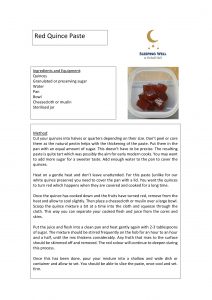








0 Comments